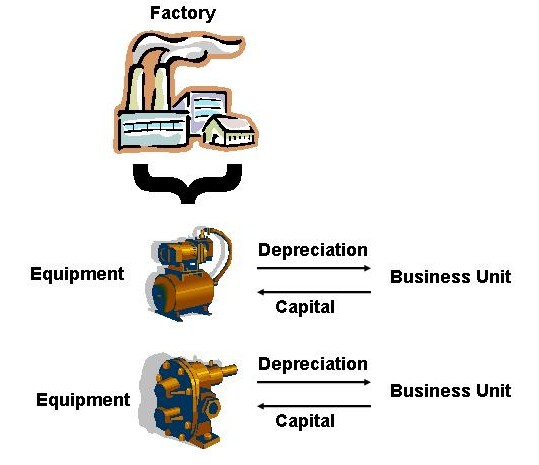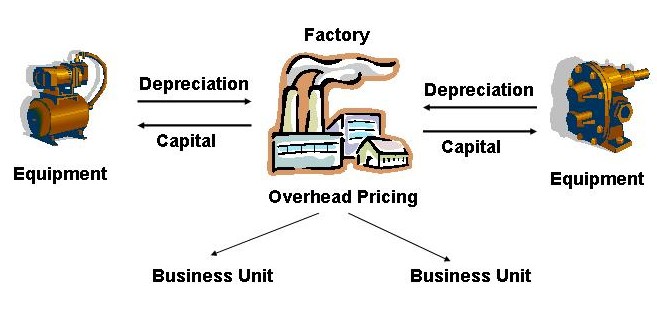In my company, the business units apply for capital and buy and "own" their own equipment, which are put into various factories. All costs and depreciation for those machines are charged back to the business unit along with all associated labor. Factory overhead is allocated based on volume.

I'll call this the "silo" business model.
The other model is where the factory "owns" all equipment and depreciation, and charges a "cost" back to the BU based on their total costs. Usually the Factory runs at breakeven Profit and Loss (P&L). I'll call this the monolithic model:

From a financial standpoint, the Silo Model makes sense since it makes the BUs bear the real costs of doing business. It shields low margin, high capital BUs from sucking resources away from higher margin, lower capital businesses. The corporation can see - almost like an independent business - the financial return for each BU better than the Monolithic model. (obviously in companies where each BU has unique factories there is no real difference between the two models).
The downside of the Silo Model is that it can create political nightmares between BUs, and create financial incentives for the BU which are detrimental to the Company as a whole. This is why most large manufacturing companies use the Monolithic Model, even though the Silo Model is financially superior. And I am in a situation showing why this is the case.
My BU needs to buy equipment - expensive equipment that costs millions of dollars. Another BU has the SAME equipment sitting idle in the SAME factory. They are not forecasted to be needing it for at least half a year.
The smart financial thing to do (from the Corporation's standpoint) is move the equipment 30 feet from one BU line to the other and spend the millions of dollars on new machinery in six months when it's needed. HOWEVER, the equipment in question is fully depreciated. The other BU doesn't want to give up the depreciated machine and take a new machine in six months since they would then have a piece of equipment that would increase their costs due to a new depreciation schedule.
So I am sitting here looking at a situation where the company has to outlay millions of dollars for one machine while an identical machine sits idle in the same factory for half a year just so the internally calculated "costs" of another BU doesn't go up. Amazing.
Maybe we'll work something out, but to tell you the truth, most managers in the corporation don't care what's "good for the company". They are worried about "what's good for my BU", which is the reason I called it the "Silo" model. Based on my experience in this company compared to another that used Monolithic pricing, I believe the Silo model encourages this type of behavior more.
So if you see me taking the CEO spot at your company, you can bet what model I will be putting into place.
The downside of the Silo Model is that it can create political nightmares between BUs, and create financial incentives for the BU which are detrimental to the Company as a whole. This is why most large manufacturing companies use the Monolithic Model, even though the Silo Model is financially superior. And I am in a situation showing why this is the case.
My BU needs to buy equipment - expensive equipment that costs millions of dollars. Another BU has the SAME equipment sitting idle in the SAME factory. They are not forecasted to be needing it for at least half a year.
The smart financial thing to do (from the Corporation's standpoint) is move the equipment 30 feet from one BU line to the other and spend the millions of dollars on new machinery in six months when it's needed. HOWEVER, the equipment in question is fully depreciated. The other BU doesn't want to give up the depreciated machine and take a new machine in six months since they would then have a piece of equipment that would increase their costs due to a new depreciation schedule.
So I am sitting here looking at a situation where the company has to outlay millions of dollars for one machine while an identical machine sits idle in the same factory for half a year just so the internally calculated "costs" of another BU doesn't go up. Amazing.
Maybe we'll work something out, but to tell you the truth, most managers in the corporation don't care what's "good for the company". They are worried about "what's good for my BU", which is the reason I called it the "Silo" model. Based on my experience in this company compared to another that used Monolithic pricing, I believe the Silo model encourages this type of behavior more.
So if you see me taking the CEO spot at your company, you can bet what model I will be putting into place.

No comments:
Post a Comment